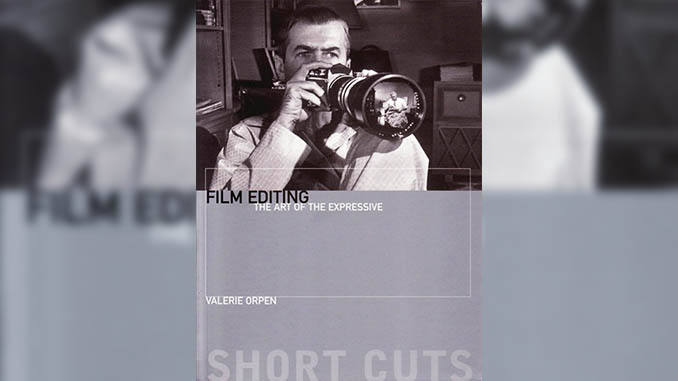
01by Ray Zone
Film Editing
The Art of the Expressive
By Valerie Orpen
Wallflower Press
138 pps., paperbound, $15.95
ISBN: 1-903364-53-1
Published as the 16th volume in the “Short Cuts” series by Wallflower Press, Film Editing: The Art of the Expressive by Valerie Orpen is a highly theoretical examination of editing as an essential but greatly misunderstood aspect of motion picture production. Though much of the discussion is complex, this study provides a bracing overview and re-examination of what editing actually is and its importance to both narrative grammar and motion picture studies.
In her introduction, Orpen sets the context by asking the fundamental question: “What is editing?” She quotes Mike Crisp, who wrote that it “comes in a category somewhere between brain surgery at one extreme and tiling the bathroom at the other.” French director Claude Chabrol made a culinary comparison by stating that if scriptwriting was cooking and shooting was eating, then editing would be like “washing-up.” With a thorough review of existing literature on editing, Orpen clearly sets the parameters for her discussion of editing as an expressive art.
Editing is generally discussed as a connective art––that is, joining disparate shots into a whole––and it is this approach that is generally taken in most film studies. But Orpen, however, is interested in shedding light on editing in a different manner. “It soon transpires from the literature that editing as an expressive technique is largely taken for granted,” she writes. “We all know that it is expressive, but it is more difficult, uncomfortable even, to explain why and how.” Orpen suggests that it is time––the crucial element of editing––that makes it “particularly arduous to quantify” and she cites Noel Burch’s use of the term “intangible” to isolate this plastic aspect of editing.
A fundamental problem in the discussion of editing as plastic or expressive art is that spectators are not generally or consciously aware of its actions. “This subliminal aspect of film viewing tends to constitute an obstacle for the film scholar,” notes Orpen. “If a cut (or even a shot) was not noticed by the audience, should we take this to mean that the editing was ‘bad’…or that it was intended to pass unnoticed? In addition, we are often faced with the paradox that many effective cuts are effective precisely because they are not noticeable.”
Ultimately, this slim but weighty tome is anything but slight.
Orpen also takes the element of sound editing under consideration in her discussion. Frequently she refers to the (now lost) Kuleshov editing experiment, in which the same shot of actor Ivan Mosjoukine bearing a neutral facial expression was juxtaposed with shots of a bowl of soup, a child playing and a woman in a coffin. In each case, as a result of the varied juxtapositions, the audience read different emotions in Mosjoukine’s face, which was unchanging. Additionally, Orpen notes that sound can also contradict or reinforce the meaning of the image editing itself.
In surveying the literature, Orpen clarifies that, “Broadly speaking, the study of the expressiveness of film editing has been polarized” between the montage theory, championed by Eisenstein and Ivanov, and deep-focus editing with long cuts, espoused by Andre Bazin. More recent studies have emphasized narrative structure and ignored editing. “I am concerned not so much with the causes of this neglect as with the need to redress the balance,” writes Orpen.
She notes that existing literature on editing consists of three categories: general studies, technical handbooks and interviews. “Very often,” she observes, “the critical scholarship on individual films can prove more useful than works on editing in general.” To that end, Orpen has included in-depth analysis of the editing on three modern sound films: Alfred Hitchcock’s Rear Window(1954), Martin Scorsese’s Raging Bull (1980) and Jean-Luc Godard’s A Bout de Souffle (1959).
The structure in which discussion of these films takes place is illuminating. Chapter One, titled “Continuity Editing in Hollywood,” compares and contrasts Rear Window, with its point-of-view editing and repetition against Raging Bull, which made innovative use of sound and image overlaps. Chapter Two, “Art Cinema and the Avant-Garde,” examines the juxtaposition of profuse jump cuts with long mobile shots in A Bout de Souffle, a radical style of editing which Orpen finds “still jars to this day” and “still arduous to interpret and conceptualize.” Chapter Three reveals the extent to which a movie star can be defined in terms of the number of reaction shots he or she elicits from other characters in the film.
Sound can contradict or reinforce the meaning of the image editing itself.
Ultimately, this slim but weighty tome is anything but slight. Included in the back of the book is an index to the illustrated sequences from the films under discussion, a cogent glossary, notes, a filmography and a wonderful bibliography of both “essential” and “secondary” readings on editing.
“Why has more attention not been paid to editing?” asks Orpen. “The impossibility of isolating editing, of disentangling it from other filmmaking aspects, partly answers the tacit and recurring question.” Also, when montage sequences in films such as Battleship Potemkin (1925) and Citizen Kane (1940) are celebrated as if editing is only important when it is memorable, Orpen observes, “This is worth reflecting on, for what strikes me as unique to editing is that it is usually impossible to remember correctly after viewing a film, no matter how many times one has seen it.”
Because of this, rather than in spite of it, “The study of editing is greatly amenable to further development,” according to Orpen. “There is certainly more work to be done on this central aspect of film art.” Orpen’s concise analysis provides an excellent marker of film editing studies produced to date as well as a cohesive map for future work.





